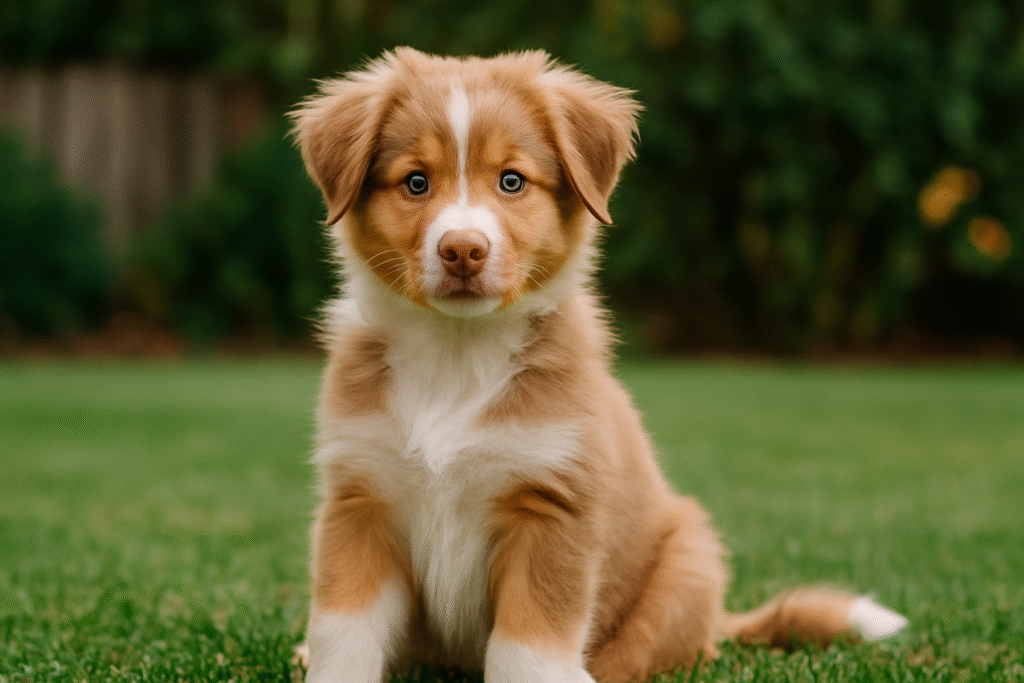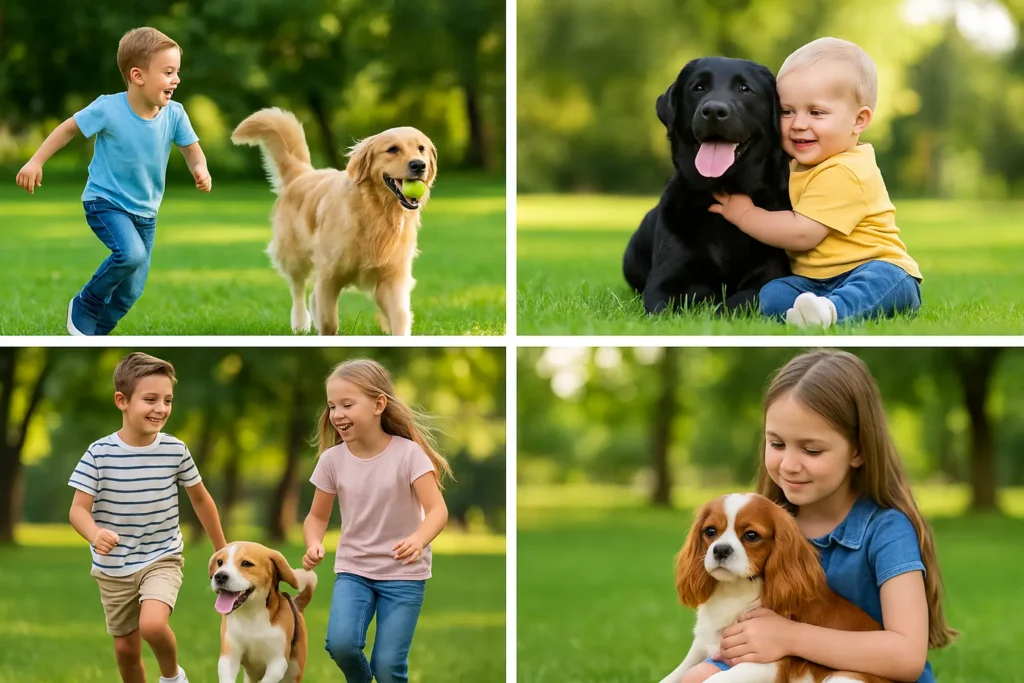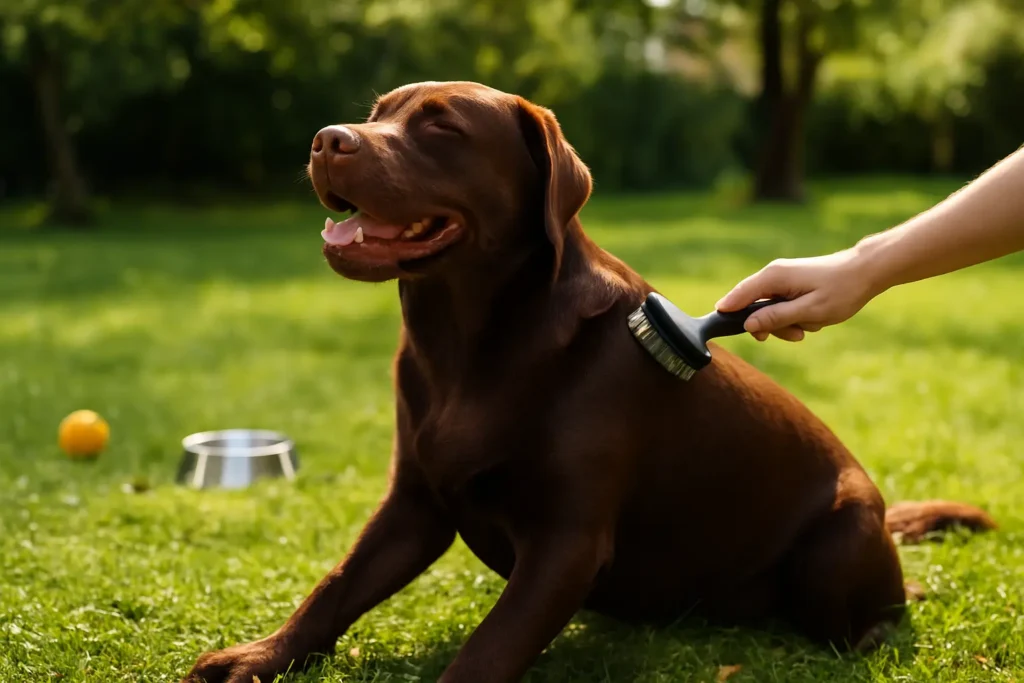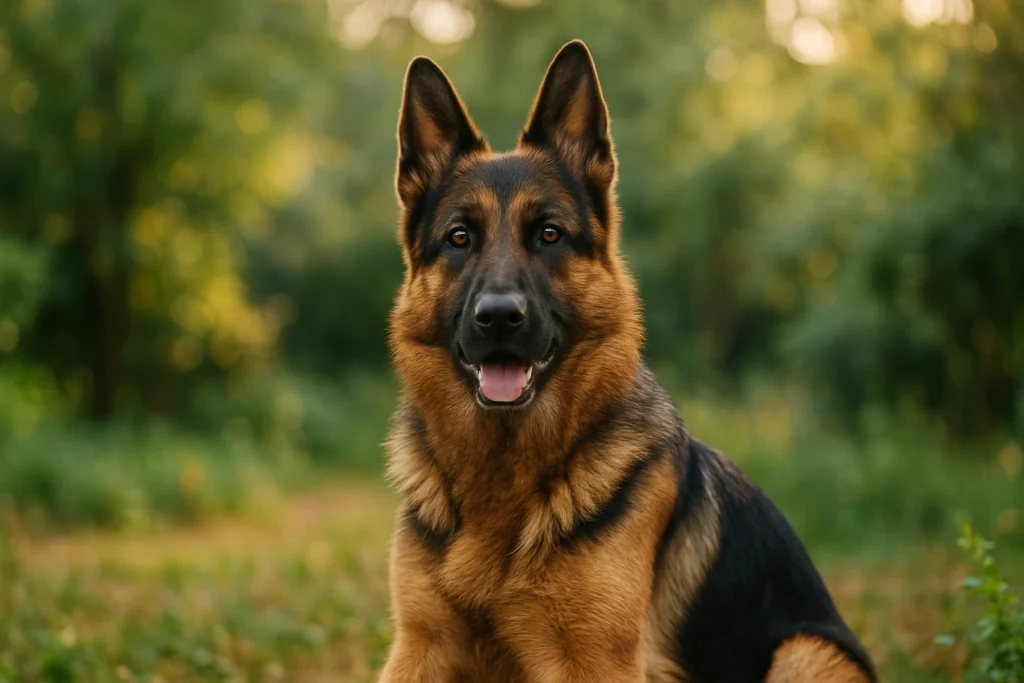Bringing a new dog home is the perfect mix of joy, chaos, and “okay… now what?” Between the zoomies, the chewing, and the big puppy eyes, it’s normal to feel a little overwhelmed about training. The good news: you don’t need to teach everything at once. Focus on a small set of foundational behaviors and you’ll set your dog up for a lifetime of good manners and clear communication.
Think of the first 10 commands as your dog’s ABCs. They keep your pup safe in public, calm at home, and tuned in to you even when the world feels distracting. Whether you’ve got an eight-week-old fluffball or a sweet adult rescue, the steps below work with patience, consistency, and rewards your dog loves.
Why basic commands matter
Safety first. “Come,” “Stay,” and “Leave it” prevent dangerous situations—bolting into traffic, grabbing something harmful, or rushing through a door. A single reliable cue can make the difference in an emergency.
Sanity at home. A dog who can “Sit,” “Down,” “Wait,” and “Off” is easier to live with. You’ll have calmer mealtimes, fewer jumpy greetings, and less chaos at the door.
Better communication. Training gives your dog a way to understand what you want. Dogs repeat what gets rewarded; if “four paws on the floor” earns attention, they’ll choose it over jumping every time.
Future-proofing. Once your dog understands the basics, everything else is easier—loose-leash walking, tricks, therapy dog prep, or just being the well-behaved buddy who can go anywhere.
Before you start: the teaching formula (use this for every command)
- Keep sessions short (5–8 minutes) and end on a win.
- Mark the moment your dog does it right—say “Yes!” or click a clicker.
- Reward immediately with a tiny treat, praise, or a quick game.
- Add the cue word once your dog is already doing the behavior.
- Practice in easy places first, then add distractions gradually.
- Be consistent. Same word, same hand signal, same rules from everyone at home.
The first 10 commands every dog should learn
1) Name & Focus (a.k.a. “Look” or “Watch me”)
Why it matters: If your dog can’t give you attention, everything else is harder. Focus is the “volume knob” that lets you turn down the world and turn up your communication.
How to teach: Say your dog’s name once. When they look at you—even for a split second—mark (“Yes!”) and reward. Add “Look” or “Watch” if you like. Practice in tiny bursts throughout the day.
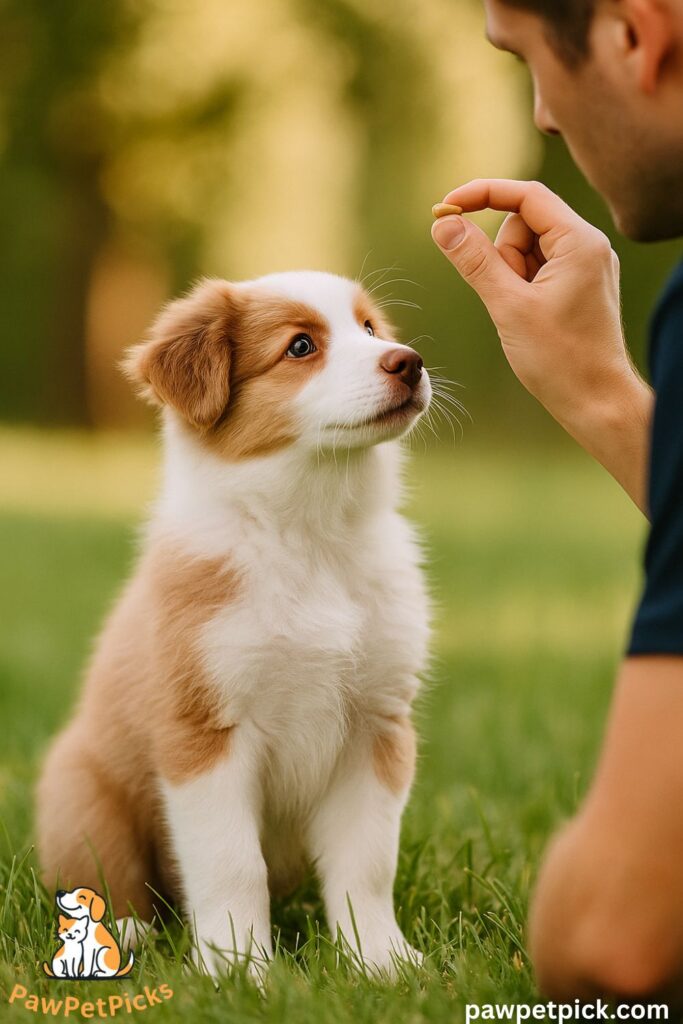
Pro tip: Reward eye contact before you ask for anything else. It’s your warm-up.
2) Sit
Why it matters: It’s polite, prevents jumping, and gives you a default behavior to ask for anywhere.
How to teach: Lure your dog’s nose up and slightly back with a treat. As the hips touch the floor, mark and reward. Add the word “Sit” once they’re offering it.
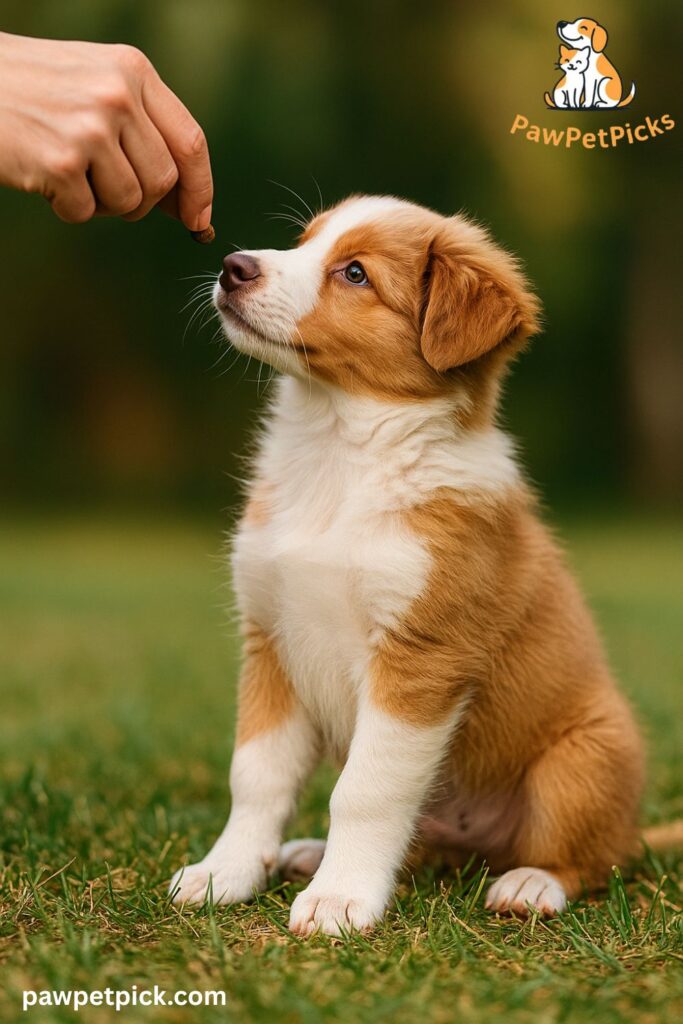
Common snag: Dog jumps for the treat? Keep the treat closer to the nose and move slowly.
3) Down
Why it matters: Encourages calmness and helps your dog settle during meals, guests, or vet visits.
How to teach: From a sit, lure the nose down between the front paws, then out along the floor like a small slide. As elbows touch, mark and reward.
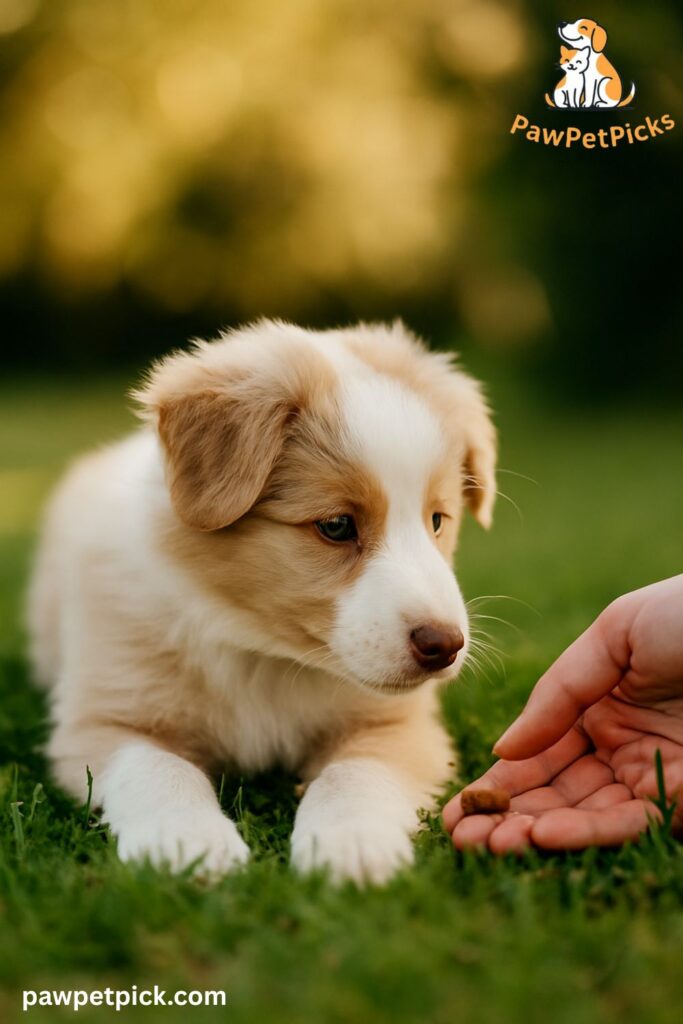
Pro tip: If your dog pops up, practice next to a wall or sofa so they can’t scoot forward.
4) Stay
Why it matters: Safety and impulse control. It’s the difference between “wait politely” and “dart out the door.”
How to teach: Ask for a sit or down. Open your palm like a stop sign and say “Stay.” Count “one-Mississippi,” mark, reward, and release with “Okay!” Build duration, then distance, then distractions—one layer at a time.
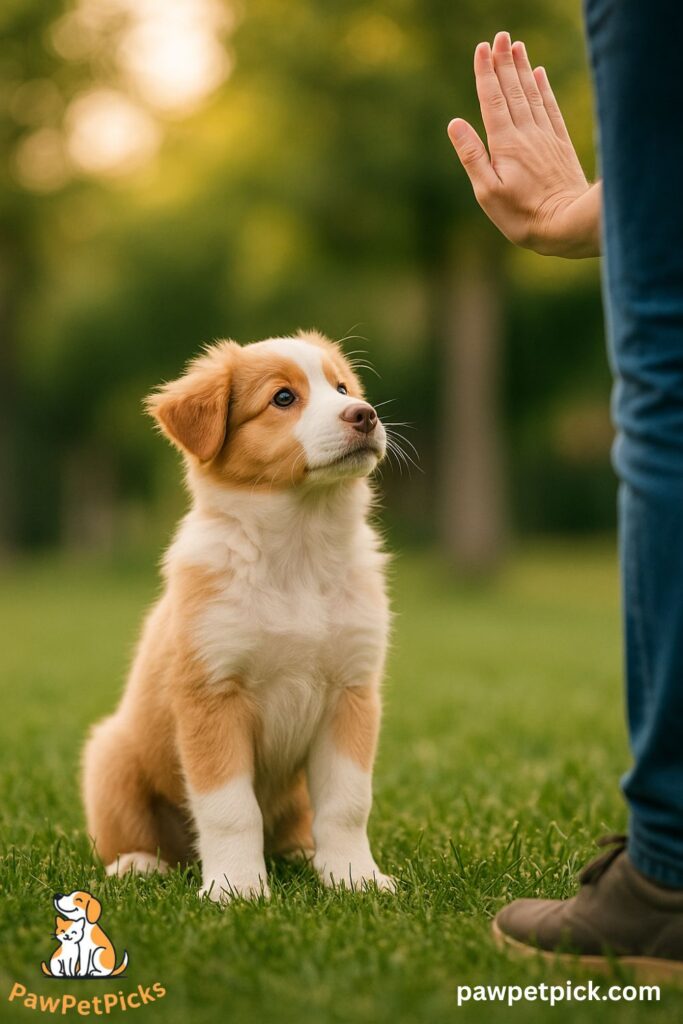
Common snag: If your dog breaks, you increase difficulty too quickly. Go back a step and shorten the time.
5) Come (Recall)
Why it matters: The lifesaver. If your dog ever slips a leash, a strong recall brings them back fast.
How to teach: Start indoors. Say “Come!” in a happy voice, step backward, and reward like you’re throwing a party when your dog reaches you. Add mild distractions later; move to a long line outside for safety.
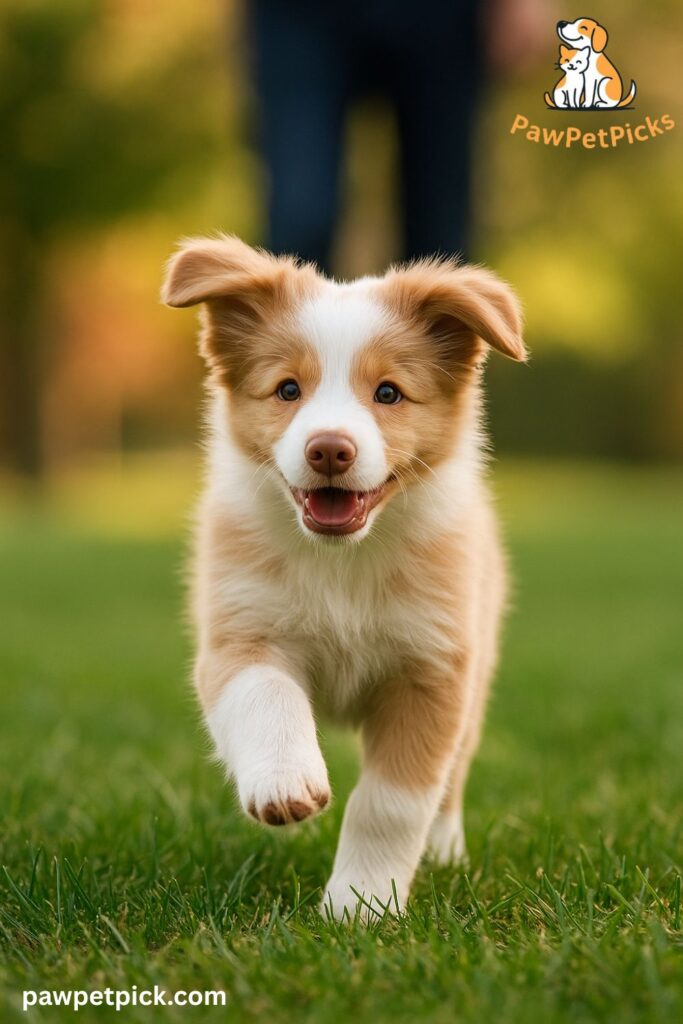
Pro tip: Never use “Come” to end fun. Sometimes reward, then let your dog go play again.
6) Leave it
Why it matters: Prevents your dog from investigating dangerous or gross things—medicine on the floor, chicken bones on the sidewalk, wildlife.
How to teach: Place a treat in a closed fist. When your dog sniffs/paws, say “Leave it.” The instant they back off or look away, mark and reward from your other hand. Gradually practice with more tempting items.
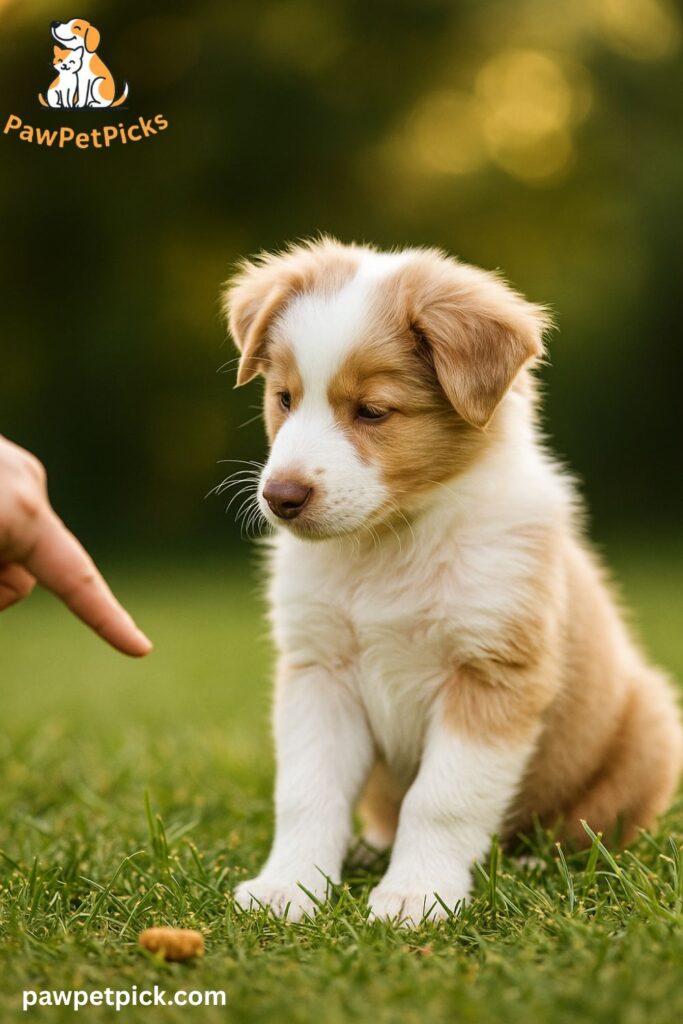
Common snag: If your dog fixates, you made it too hard. Lower the temptation, reward faster.
7) Drop it
Why it matters: Essential for toys, socks, sticks—anything your dog shouldn’t keep.
How to teach: Offer a toy. Present a high-value treat at the nose and say “Drop it.” When your dog releases, mark and reward. Often, trade the toy back to keep the game going.
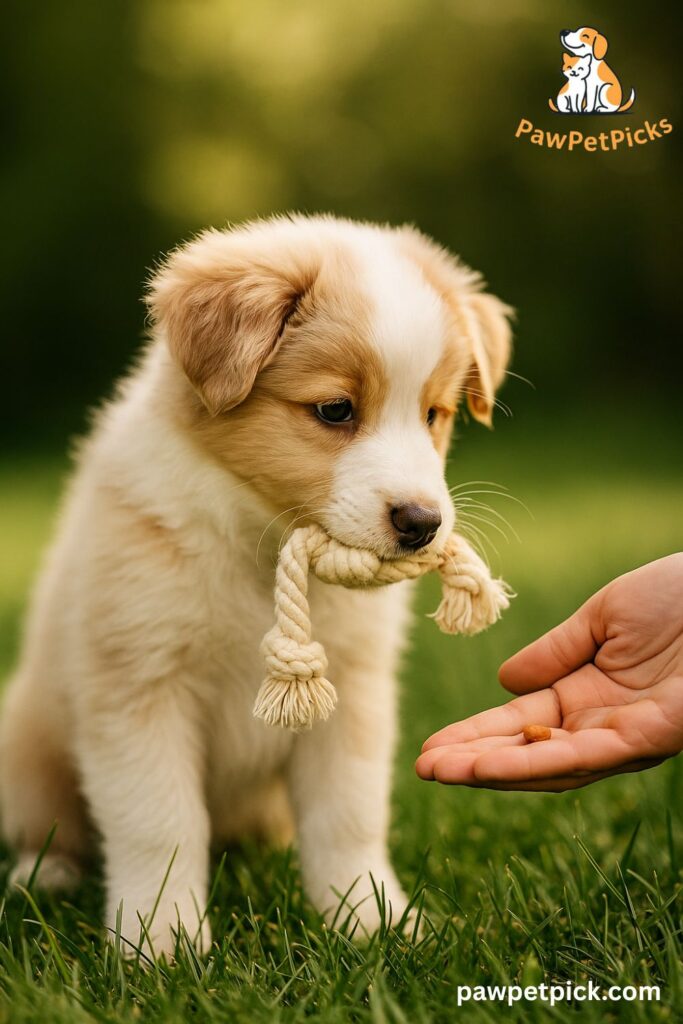
Pro tip: Teach “Drop it” before you truly need it. Emergency trades are easier when the rules are familiar.
8) Heel / Loose-Leash Walking
Why it matters: Walks should relax you both, not feel like a tug-of-war.
How to teach: In a quiet area, hold a treat at your thigh. Take a step; when your dog is beside you and the leash is slack, mark and reward. If they pull, stop. Wait for slack to reappear, then move.
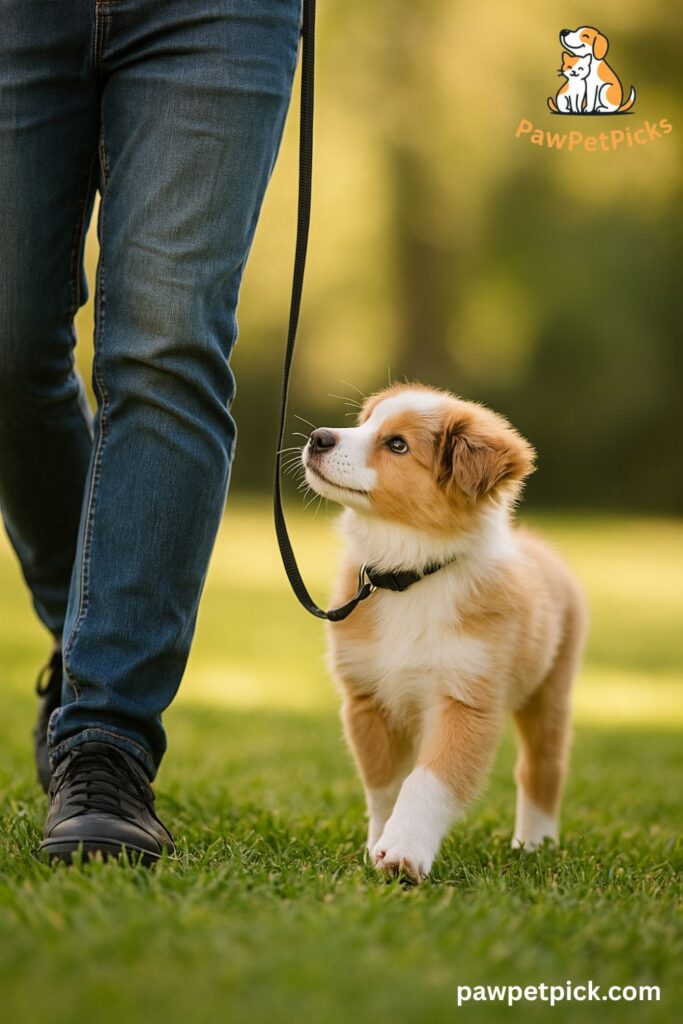
Common snag: Consistency. If pulling sometimes gets your dog where they want to go, they’ll keep trying it.
9) Wait
Why it matters: Brief pause at doorways, gates, curbs, and food bowls. Different from “Stay”—it’s short and situation-specific.
How to teach: Approach a doorway. Say “Wait,” reach for the handle, and pause. If your dog holds position, mark, then release with “Okay!” and go through together.
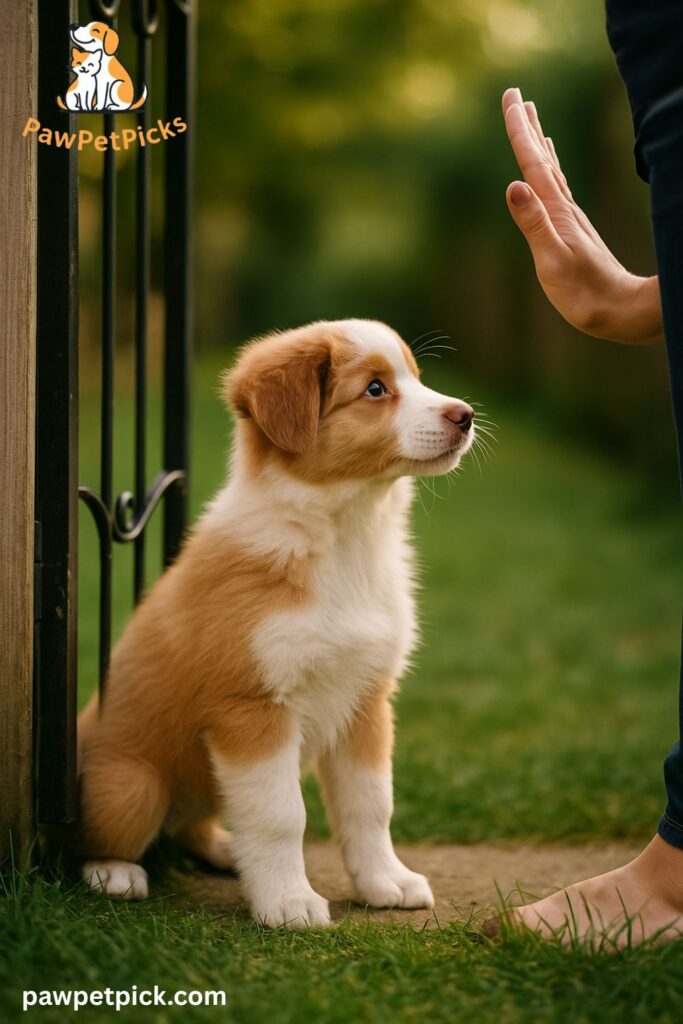
Pro tip: Use “Wait” everywhere—car doors, elevators, curb cuts—so it becomes a habit.
10) Off
Why it matters: Ends jumping on people and keeps paws off counters and furniture you’d like to protect.
How to teach: When your dog jumps, calmly step back and say “Off.” The moment four paws hit the floor, mark and reward. Ask for a seat to reinforce a polite greeting.
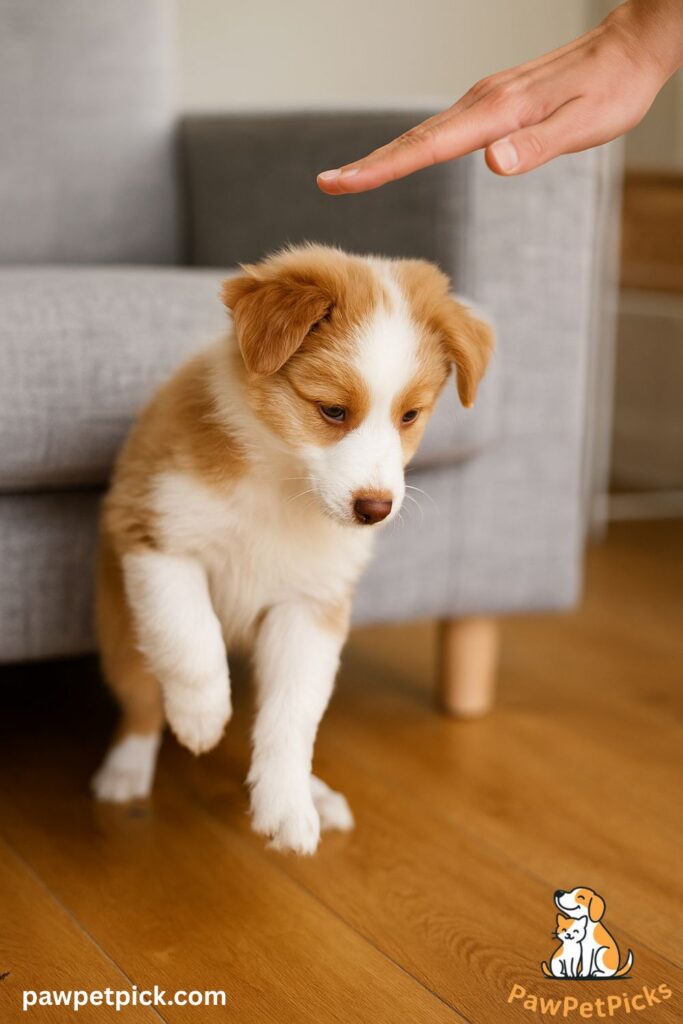
Common snag: Attention fuels jumping. If you laugh, shout, or push, many dogs see it as a fun game.
Real-life mini-scenarios (how the basics pay off)
- Front door chaos: Guests arrive, your dog wants to launch. You quietly ask for “Sit, Wait.” Your friend steps in; you release and reward calm behavior. No wrestling, no apologies.
- Park distractions: Squirrels, kids, smells. You cue “Look,” your dog checks in, then you ask for “Heel.” You pass the chaos like a team.
- Kitchen safety: A glass falls. You say “Leave it,” then “Wait.” No shredded paws, no vet visit, no drama.
- Emergency moment: Gate left open by a delivery driver. You call “Come!” Your dog spins on a dime. That one trained behavior is priceless.
Training tips that speed results
- Train tiny and often. Three to five minisessions beat one marathon.
- Use great rewards. Many small wins, not one huge cookie. Mix treats, praise, and play.
- Change one thing at a time. First duration, then distance, then distractions.
- End while it’s fun. Quit after a success so your dog wants the next session.
- Generalize. Practice in the kitchen, hallway, yard, sidewalk, park. Dogs don’t automatically know “Sit” means “Sit” everywhere.
Common beginner mistakes and how to fix them
1) Inconsistency
What happens: You say “Down,” your partner says “Lay,” your kid says “Off.” Your dog hears static.
Fix it: Pick one cue per behavior and write them on a fridge note everyone can see. Consistency wins.
2) Using punishment
What happens: Yelling or leash pops may stop a behavior in the moment but can create stress or fear—and fear dogs don’t learn well.
Fix it: Reward what you want, manage what you don’t. If your dog counter-surfs, block access and reward lying on a mat while you cook.
3) Rushing the steps
What happens: You go from the living room to a busy park in one day and your dog “forgets everything.”
Fix it: Build difficulty slowly. New place? Drop your expectations and reward generously again.
4) Training only at home
What happens: Your dog is a superstar in the kitchen… and a tornado on the sidewalk.
Fix it: Practice in new places: lobby, driveway, quiet street, busier street. Treat each jump in difficulty like a fresh lesson.
5) Only food, no life rewards
What happens: The Dog listens when you have treats, not otherwise.
Fix it: Reward with what your dog wants at that moment: sniffing a tree, greeting a friend, or rushing to a toy. Ask for “Sit,” then release the reward.
Simple one-week starter plan
- Day 1: Name/Focus, Sit (3 minisessions)
- Day 2: Down, Wait at doorways
- Day 3: Stay (2–3 seconds), Come (short distance indoors)
- Day 4: Leave it (closed hand), Drop it (toy trades)
- Day 5: Heel starts indoors, add short hallway walks
- Day 6: Practice outside in a quiet spot (lower criteria)
- Day 7: “Mix & match” review + easy real-world reps (doorbell practice, curb waits)
Repeat weekly, gradually adding duration, distance, and distractions.
Tools that make training easier (optional but helpful)
- Treat pouch: Fast delivery = clearer feedback.
- Clicker: Consistent “you got it” marker. A happy “Yes!” works too.
- Front-clip harness & 6-ft leash: Better control for loose-leash practice.
- Mat/bed: A portable “settle” spot for restaurants and guests.
- Chew toys & food puzzles: Mental work tires brains; tired brains make better choices.
When to call a professional trainer
If you’re seeing aggression, intense fear, resource guarding, or you just feel stuck after a few weeks of consistent practice, bring in a certified trainer who uses reward-based methods. Group puppy classes are also fantastic for socialization and for learning how to work around other dogs and people.
Encouragement for the road
Training isn’t a straight line. Some days your dog will be a genius, and other days the wind smells too interesting to focus. That’s normal. Celebrate the small wins—a one-second “Stay,” a single check-in during a walk, a quick “Drop it” trade. Those micro-moments compound into a well-mannered, confident dog who understands you and trusts you.
If you’ve just started and you’re wondering whether you’re “doing it right,” you are. You showed up, you’re reading, and you’re ready to practice. Your dog doesn’t need perfection; your dog needs you—present, patient, and consistent.

